‘A bit of history will go with him when he retires’: Rainer Banzhaf is leaving the DRF Luftrettung alert centre after 42 years
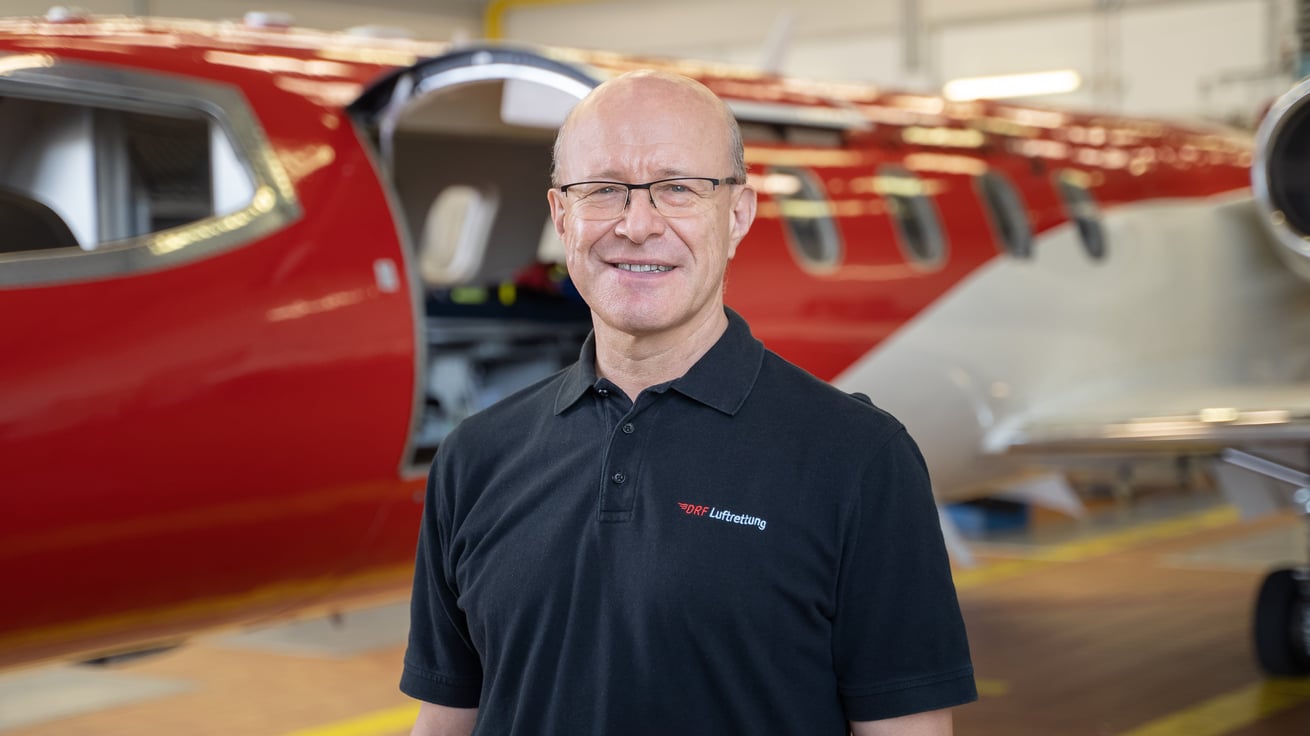
Working for DRF Luftrettung since 1979: Rainer Banzhaf. (Source: DRF Luftrettung)
Rainer Banzhaf has worked at DRF Luftrettung since 1 August 1979. The mission coordinator, whose employee number is 001, has been part of the DRF Luftrettung alert centre’s development. He has given passion, fascination and commitment. He will be beginning his well-earned retirement in November and can look back on a work history spent almost entirely at the non-profit organisation. His emphasis on team spirit has been there since the very beginning.
Rainer Banzhaf has been fascinated by aviation ever since his childhood. Directly after finishing school, he decided to complete a training programme with Germany’s air traffic control (Bundesanstalt für Flugsicherung then, Deutsche Flugsicherung now). He subsequently obtained his first job as a flight data specialist, i.e. an air traffic control assistant, in aeronautical information and aeronautical fixed service – a civil-servant role in mid-grade, non-technical service.
Joining the alert centre as a flight data specialist and rescue assistant
When he was conscripted into military service, he refused to join the armed forces and looked for a position in the civilian service instead. This brought him to DRF Luftrettung, which was called Deutsche Rettungsflugwacht (German Air Rescue Service) back then. He was already familiar with the organisation owing to his air traffic control work. It offered positions for people doing civilian service, giving him an opportunity that he made sure to use: “Way back in 1978, I was already interested in working for DRF Luftrettung. Aviation had an enormous appeal for me, and the combination of that with the idea of doing something good and helping to save people’s lives was exactly the right mix for me. I was able to achieve my wish one year later when I had my first day of work on 1 August 1979. I was 23 years old.”
He started in the donor department, where he served the organisation’s members. At the same time, he began a three-month traineeship to become a rescue paramedic at DRF Luftrettung. After a short while, he was given the opportunity to switch to the alert centre. Accordingly, Rainer Banzhaf has worked as a mission coordinator since December 1980, fielding calls from all over the world with the same single objective: of helping people in medical emergencies and getting them home safely using DRF Luftrettung’s aircraft.
Rainer is kind, authentic and empathetic. This is particularly important because many of the people calling the alert centre are in a crisis situation. He is someone who is there for people, practising our motto of “Saving. People’s. Lives.” from the very first moment through to today
Peter Keidler, Deputy Head of Flight Operation at DRF Luftrettung

Peter Kreidler, Deputy Head of Flight Operations at DRF Luftrettung, appreciates the empathetic approach that Rainer Banzhaft takes with callers in the DRF Luftrettung Operations Center. (Source: DRF Luftrettung)
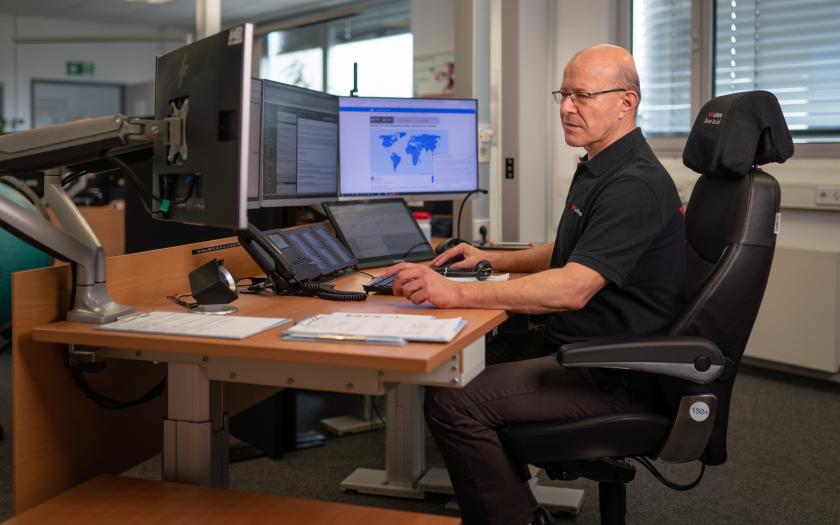
Aviation and medical knowledge as well as good cognitive skills and an interest in global geography: the work of a mission coordinator requires versatility. (Source: DRF Luftrettung)
Every alert is unique
The work that an alert centre does is distinct for constantly having new tasks with a demanding learning curve. In the 1980s, for example, DRF Luftrettung was highly active in disaster response and refugee aid, and also oversaw organ transport for transplants. It is work that demands a large degree of flexibility from the team members, as anyone who answered the phone at the alarm centre back then would have to go from coordinating an ambulance aircraft on one call to organising a helicopter for the next. ‘Mentally, we had to be able to change our thinking quite quickly,’ Rainer Banzhaf remembers.
‘Rainer is kind, authentic and empathetic. This is particularly important because many of the people calling the alert centre are in a crisis situation. He is someone who is there for people, practising our motto of “Saving. People’s. Lives.” from the very first moment through to today,’ says Peter Keidler, Deputy Head of Flight Operation at DRF Luftrettung, describing his colleague.
Rainer Banzhaf says that the general range of duties for the alert centre has not changed much since the 1980s. Along with receiving alerts, the mission coordinators’ work also includes assessing the transport options, the associated requirements such as overflight permits and possibilities for refuelling and stopovers, the geopolitical situation and clarifying the mission’s medical feasibility. They calculate flight prices and maintain contact with clients. ‘Depending on the needs, we also work closely with the Zentrale Koordinierungsstelle (‘central coordination office’), which dispatches air- and ground-based intensive-care transport in Baden-Württemberg and can therefore arrange onward transport for our patients.’
.jpg?width=840&height=525&name=Rainer%20Banzhaf%20(6).jpg)
Rainer Banzhaf has helped many patients in 42 years as an operations coordinator at DRF Luftrettung. (Source: DRF Luftrettung)
However, from a technical perspective, there are major differences between the olden days and today. ‘When we began, we still communicated by short wave and using teletype and punched tape, which were telegraphic devices for sending written messages through electric signals. It was an enormous relief when the first fax machines arrived. These days, nearly everything is done digitally.’
His memories of ‘the olden days’ are something very special for his colleagues at the alert centre. ‘I like it a lot when he talks about past decades at DRF Luftrettung and all of its transformations. They speak of a time somewhere between the Wright brothers, Björn Steiger and the present day. Stories from a world of videotex devices and teleprinters or aeronautical radio service between the alert centre and aircraft,’ says Carsten Atrops, who also works as a mission coordinator.
There is something else that has changed over time: the DRF Luftrettung ‘team’, which started out somewhat small in size before employee numbers grew with the increasing importance of air rescue. ‘A logical consequence of this was the introduction of employee numbers – which was done in alphabetical order back then. My surname must have been first in the system at the time, so I have been number 001 ever since,’ he chuckles.
In 2007 and 2008, the alert centre changed its German name to Einsatzzentrale (mission headquarters) and moved to its current building at the Karlsruhe/Baden-Baden airport.
A joint venture with Luxembourg’s air rescue service, Luxemburger Rettungsflugwacht, brought new developments with it, with the alert centre beginning to receive alerts for their colleagues in Luxembourg and processing them. Many of the processes needed after an alert were moved together to the same place.
When we began, we still communicated by short wave and using teletype and punched tape, which were telegraphic devices for sending written messages through electric signals. It was an enormous relief when the first fax machines arrived. These days, nearly everything is done digitally.
Rainer Banzhaf
Many co-workers, one team: air rescue only works when it is hand in hand
When a phone rings at the alert centre, it sets off a chain of different processes. With the help of the doctors who clarify the situation, the centre first evaluates if the mission is feasible. If so, an alert is made. For the mission coordinator, that means doing one thing first: rostering a crew. The pilot on duty informs him or her about the teams that are on flight duty. The coordinator gives the pilot the medical crew along with all the basic information about the equipment needed for the mission. A take-off time is set for the flight, and the expectation is that it will be punctual. Parallel to this, information and instructions must be given to the volunteers who are doing national service in the technology department and prepare the Learjet for the mission. ‘We are constantly right in the middle of all the work and simultaneously make sure that all the information and instructions are conveyed to everyone involved in an understandable and friendly manner – there has to be the right atmosphere, that is important,’ Rainer Banzhaf reveals.
.jpg?width=840&height=525&name=Rainer%20Banzhaf_Christopher%20Bormann%20(2).jpg)
Christopher Bormann (from right) succeeds Rainer Banzhaf after his departure as Operations Coordinator at the DRF Luftrettung Operations Center. (Source: DRF Luftrettung)
The way he sees it, the ‘alert centre team’ includes far more people than just the mission coordinators. Pilots, medical crews and colleagues at the Zentrale Koordinierungsstelle are all part of it, just as the technology department is too. ‘The national-service volunteers are also a core element of our team, without a doubt. On top of that, there are a vast number of areas that help to bring our missions to fruition,’ Rainer Banzhaf says. Everyone in this hive does what they can, which is something he thinks should be natural, ‘I am also happy to take questions and look after things that still need doing. I don’t think these things are beneath me; it’s what I think the word “team” means. I am a cog in a wheel full of little cogs, and we all need to work with each other to make everything work.’
A mission coordinator’s work: a combined effort
A position at the alert centre is not a classic career that you can train for. The role of a mission coordinator developed during the 1970s, with interested individuals usually coming from backgrounds in aviation. ‘For example, trained dispatchers – that is, people who create flight plans and prepare flights – have the ideal background for working with us. They create flight plans in just the way that pilots need them in order to get permission to start the flight,’ Rainer Banzhaf says. These flight plans are filed with air traffic control and activated.
In addition to aviation expertise, medical knowledge is also a helping factor, as patient diagnoses are sent directly with the alert. ‘Those who have an idea about these things have a clear benefit,’ he explains.
Other things that make the work easier are good cognitive skills and an interest in global geography. ‘These helped me a lot personally,’ he confirms. A conversation with his colleague Daniel Hodapp makes it clear that Rainer Banzhaf is a little modest in this respect: ‘No matter what emergency call we receive, no matter how distant the location of the caller, Rainer will almost always know the region, the local customs and the conditions based on previous missions. A lot of the time, he has even been to these places. It is precisely because of this that he can offer a special feeling of assurance to the accident victims or sick people calling. It constantly impresses me.’ Carsten Atrops confirms this, too: ‘Rainer is the man for any matter that demands experience. Any time I’m working on an ambulance flight request, I’m always happy if he is on shift as well because he always at least one impeccable tip at the ready for almost any location in the world, and also knows the right airport for it. These tips give me much better and faster help than any research I could do myself. His experience is a basis that I can build on in a targeted way.’
.jpg?width=840&height=525&name=Rainer%20Banzhaf%20(2).jpg)
The Operations Center and ZKS often work hand in hand: the colleagues here have the necessary background and the right personnel to carry out repatriations and transfers - 24 hours a day, 7 days a week. Rainer Banzhaf particularly appreciates the collegial cooperation within the team. (Source: DRF Luftrettung)
No matter what emergency call we receive, no matter how distant the location of the caller, Rainer will almost always know the region, the local customs and the conditions based on previous missions.
Daniel Hodapp, Mission Coordinator DRF Luftrettung
Language skills are essential: ‘English is fundamental for the alert centre’s operations. Any additional languages are an advantage,’ says Rainer Banzhaf. Just last year, the importance of this aspect became powerfully clear when DRF Luftrettung needed to fly patients from France to Germany for treatment during the coronavirus pandemic, to help relieve the French healthcare system. ‘One of our colleagues, for example, had worked in France and spoke French fluently. That was worth gold during this time,’ Rainer Banzhaf explains.
Always fully devoted to his duties
When Rainer Banzhaf retires from DRF Luftrettung in November, he will be walking out full of memories and gratitude. ‘There really isn’t a single mission that stands out in my mind from all these years,’ he ponders, ‘Rather, it’s a series of images that have left a mark on me. For instance, a small girl just a few years old who had already had open-heart surgery three times. It’s something that makes you think.’
The alert centre team have nothing but good wishes for Rainer Banzhaf and already miss their colleague: ‘He was an extremely friendly colleague in my experience. He was always there if you needed help and got a number of people out of a tight spot over the years,’ says mission coordinator Andreas Moser. Likewise, his co-worker Marco Bauer only has positive things to say: ‘I had the privilege of meeting Rainer 10 years ago. Over the many shifts we did together, I came to appreciate his calm and composed style. It was an honour to learn from him during these years.’
‘I hope that Rainer is able to keep all these things, experiences and stories in his heart in a positive way during an exciting retirement. I think he probably has things going on in his life that he can finally give more energy to now,’ says Carsten Atrops on behalf of his colleagues. And Daniel Hodapp adds, ‘Rainer has known the ins and outs of ambulance flights since they began. A bit of history will go with him when he retires.’
Over the many shifts we did together, I came to appreciate his calm and composed style. It was an honour to learn from him during these years.
Marco Bauer, Mission Coordinator DRF Luftrettung
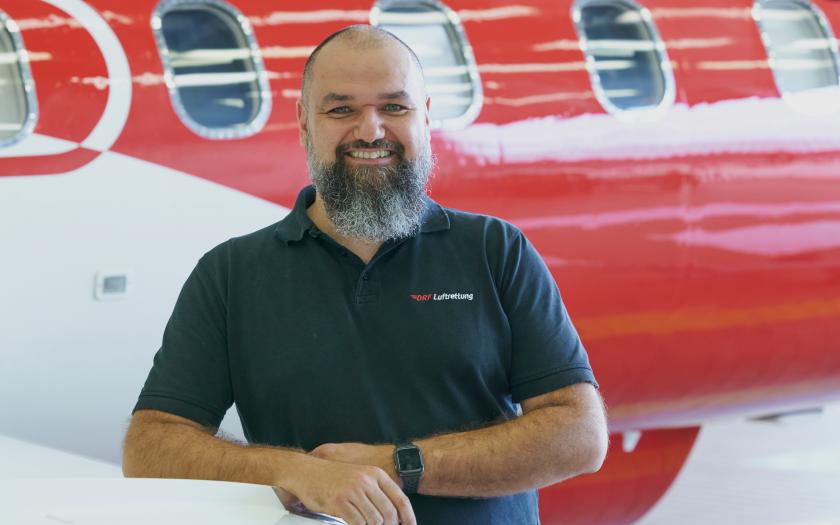
"Rainer Banzhaft never ceases to impress me," says Daniel Hodapp, Operations Coordinator at the DRF Luftrettung Operations Center. (Source: DRF Luftrettung)
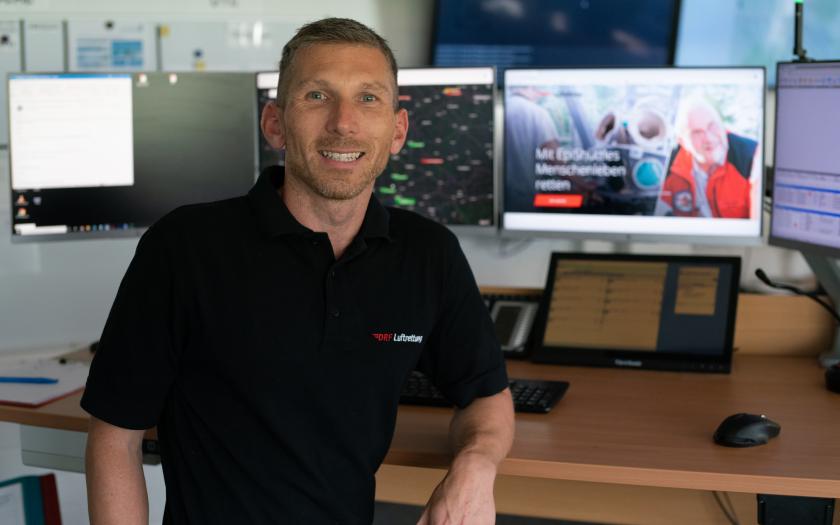
Colleague Marco Bauer has come to appreciate Rainer Banzhaft's calm and composed manner in many joint missions. (Source: DRF Luftrettung)
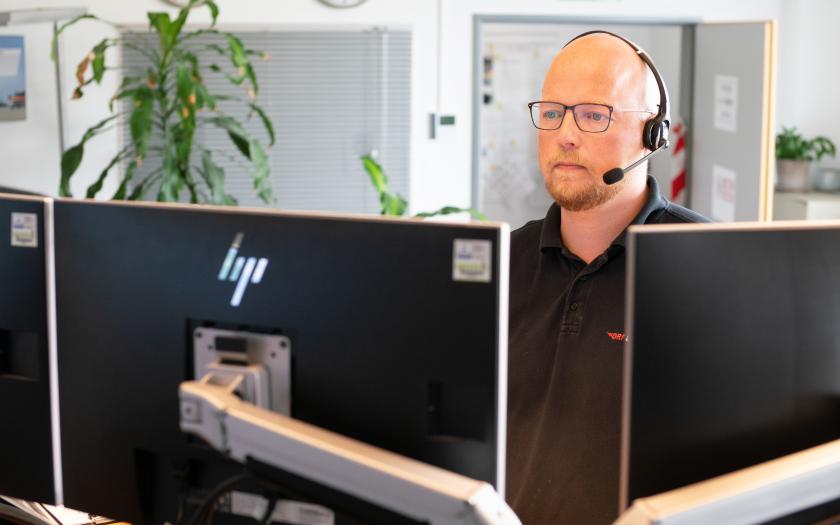
For Carsten Atrops, also Operations Coordinator at the DRF Luftrettung Operations Center, Rainer Banzhaft was and is the man for all matters where experience is required. (Source: DRF Luftrettung)
He is looking forward to the next stage of his life, especially as it will not involve shift work. ‘I’m looking forward to the weekends, too,’ he adds, ‘I will now have more time for friends, acquaintances and family. I can focus on my bible study more and I’m planning on travelling as well. There won’t be anything “missing” in my life and I don’t think I’ll be bored.’ He will certainly be paying a visit to his old colleagues now and again, he assures them and adds the opinion he has of them: ‘Things simply don’t work without the alert centre and Zentrale Koordinationsstelle. We here have the necessary background and the right personnel for carrying out repairs and patient transport 24 hours a day, 7 days a week. There is one thing above all that I would like to tell my colleagues: stay cooperative, stay forgiving – remain how you are right now. That is what makes our team what it is.’
We wish all the best to Rainer Banzhaf! Thank you – including on behalf of our patients – for your commitment and work over the last 42 years.
Author: Claudia Ziegler - Pressereferentin
